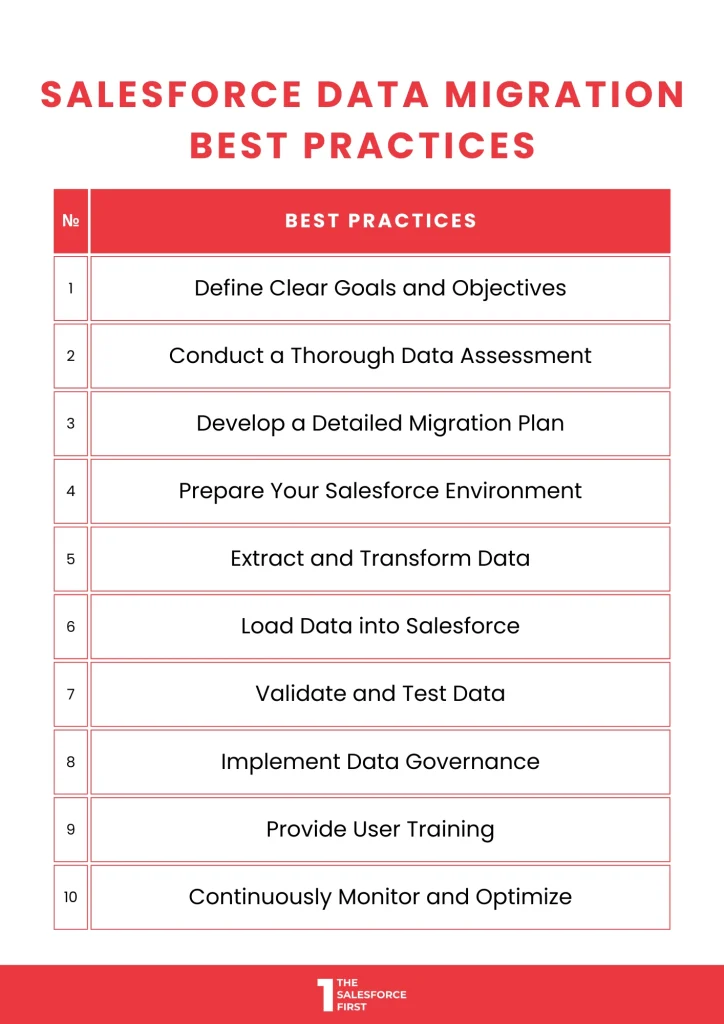Salesforce data migration is a critical process for organizations that want to leverage the power of Salesforce’s CRM platform. By effectively transferring data from existing systems to Salesforce, businesses can improve data quality, enhance efficiency, and gain valuable insights into their operations.
However, a successful data migration requires careful planning, execution, and adherence to best practices. This guide provides a comprehensive overview of the Salesforce data Migration Best Practices.
Table of Contents
What is Salesforce Data Migration?
Imagine you’re moving into a new home. You’ll need to carefully pack your belongings, transport them to the new address, and unpack them in the right places.
Salesforce data migration is similar.
It’s the process of transferring data from your existing CRM system (or other data sources) to Salesforce. This involves carefully extracting, transforming, and loading (ETL) your data to ensure a smooth transition and minimize disruptions to your business operations.
Benefits of Following Salesforce Data Migration Best Practices
Adhering to Salesforce data migration best practices ensures a smooth, efficient, and risk-free transition. Here are some key benefits:
- Reduced Risk of Data Loss or Corruption: Following best practices helps prevent data loss or corruption during the migration process, safeguarding valuable customer and business information.
- Improved Data Quality and Accuracy: By implementing data cleansing and validation procedures, you can ensure that your migrated data is accurate, consistent, and free from errors.
- Faster Migration Time: Adhering to best practices can streamline the migration process, reducing the time required to complete the transition.
- Enhanced Business Continuity: A well-planned and executed migration minimizes disruptions to your business operations, ensuring minimal downtime and maintaining customer satisfaction.
- Increased ROI on Salesforce Investment: A successful migration maximizes the value you derive from your Salesforce investment by ensuring optimal data utilization and performance.
- Compliance with Regulations: For industries with strict data privacy and security regulations (e.g., healthcare, finance), following best practices helps ensure compliance and avoid penalties.
- Scalability and Future-Proofing: A well-structured migration foundation lays the groundwork for future growth and scalability, allowing you to easily adapt to changing business needs.
By prioritizing best practices, you can mitigate risks, improve data quality, and maximize the benefits of your Salesforce implementation.
Salesforce Data Migration Steps
1. Identify the Data to Migrate
- Object Selection: Choose the specific Salesforce objects you want to migrate based on your business needs. Consider factors like data volume, importance, and dependencies.
- Data Subsets: If necessary, narrow down the data within each object to specific records or fields. For example, you might only migrate contacts from accounts in a particular division.
2. Create Data Templates
- Data Loader Export: Use Data Loader to export sample data from your existing Salesforce organization. This will provide you with a template containing the correct field names, data types, and required relationships.
- Template Customization: Modify the template to include any additional fields or data that need to be migrated. Ensure that the template aligns with the data structure of your target Salesforce organization.
3. Populate Templates with Data
- Data Validation: Review and clean your data before entering it into the templates. This includes checking for inconsistencies, errors, or missing information.
- Incremental Loading: Consider loading data in batches or increments to test the migration process and identify any issues early on.
4. Prepare the Destination Salesforce Organization
- Custom Fields: Create custom fields in your destination organization to accommodate any data that doesn’t directly map to standard Salesforce fields.
- External IDs: For fields that need to maintain relationships or be used in custom reports, consider making them “External ID” fields. This will ensure that the data is indexed and can be easily referenced.
- Legacy Data Storage: If you need to preserve historical data from your old organization, create custom fields to store legacy identifiers or other relevant information.
5. Validate the Data
- Custom Reports: Create custom reports to compare the data in your templates with the data in your existing Salesforce organization. This will help you identify any discrepancies or inconsistencies.
- Spot Checks: Manually review a sample of records to ensure that the data has been migrated correctly and that relationships are intact.
- Data Quality Tools: If necessary, use data quality tools to automate data validation and identify potential issues.
By following these steps and carefully considering the specific requirements of your migration, you can ensure a successful and efficient transition to Salesforce.
Essential Salesforce Data Migration Best Practices

1. Define Clear Goals and Objectives
- Migration Purpose: Clearly articulate the reasons for the migration. Are you aiming to improve data quality, streamline processes, or enhance customer experiences?
- Desired Outcomes: Define specific goals, such as increased sales, improved customer satisfaction, or better reporting capabilities.
- Key Metrics: Identify measurable metrics to track the success of the migration. Examples include data quality improvements, reduction in manual tasks, or increased user adoption.
2. Conduct a Thorough Data Assessment
- Data Inventory: Catalog all existing data sources, including their formats and locations.
- Data Quality: Assess the quality of the data, looking for inconsistencies, duplicates, or missing information.
- Data Mapping: Determine how data from your current system will map to Salesforce objects, fields, and relationships.
3. Develop a Detailed Migration Plan
- Project Timeline: Create a detailed project plan outlining key milestones, deadlines, and resource allocation.
- ETL Process: Define the extract, transform, and load (ETL) steps involved in the migration, including the tools and techniques to be used.
- Data Validation: Develop a robust data validation strategy to ensure data integrity and accuracy throughout the process.
4. Prepare Your Salesforce Environment
- Object and Field Customization: Customize Salesforce objects, fields, and relationships to match your specific business requirements.
- Data Validation Rules: Set up data validation rules to prevent the entry of invalid or inconsistent data.
- Workflows and Approvals: Configure workflows and approvals to automate processes and ensure data accuracy.
5. Extract and Transform Data
- Data Extraction: Extract data from your existing system using appropriate tools and methods, such as APIs, database queries, or data loaders.
- Data Transformation: Transform the extracted data to match Salesforce’s data model and formatting requirements.
- Data Cleansing: Cleanse the data to remove duplicates, errors, and inconsistencies.
6. Load Data into Salesforce
- Bulk Loading or API: Use bulk loading or API methods to efficiently load large amounts of data into Salesforce.
- Error Handling: Implement error handling mechanisms to identify and address any issues during the loading process.
7. Validate and Test Data
- Data Comparison: Compare the migrated data with the original data to ensure accuracy and completeness.
- Functional Testing: Test Salesforce features and functionality to verify that the migrated data is being used correctly.
- User Acceptance Testing (UAT): Involve end-users in UAT to ensure that the migrated data meets their needs and expectations.
8. Implement Data Governance
- Data Ownership: Assign data ownership and responsibilities to ensure data quality and consistency.
- Data Quality Standards: Establish data quality standards and guidelines to maintain data integrity.
- Monitoring and Improvement: Continuously monitor data quality and implement improvement measures as needed.
9. Provide User Training
- Training Programs: Develop comprehensive training programs to educate users on how to effectively use Salesforce.
- Support Resources: Provide ongoing support and assistance to help users with questions or issues.
10. Continuously Monitor and Optimize
- Performance Monitoring: Monitor Salesforce performance to identify any bottlenecks or issues.
- Data Quality Assessment: Regularly assess data quality and take corrective actions as needed.
- Process Optimization: Continuously evaluate and optimize your data migration processes to improve efficiency and effectiveness.

End Note
By following the Salesforce data migration best practices outlined in this guide, organizations can ensure a smooth and successful data migration. A well-executed migration can significantly improve data quality, enhance business processes, and drive better decision-making.
Remember to prioritize clear objectives, thorough data assessment, and ongoing monitoring and optimization. With careful planning and execution, you can maximize the benefits of Salesforce and achieve your business goals.
So, ready to take your Salesforce data migration to the next level? Opt for Salesforce consultation for tailored guidance and support.



